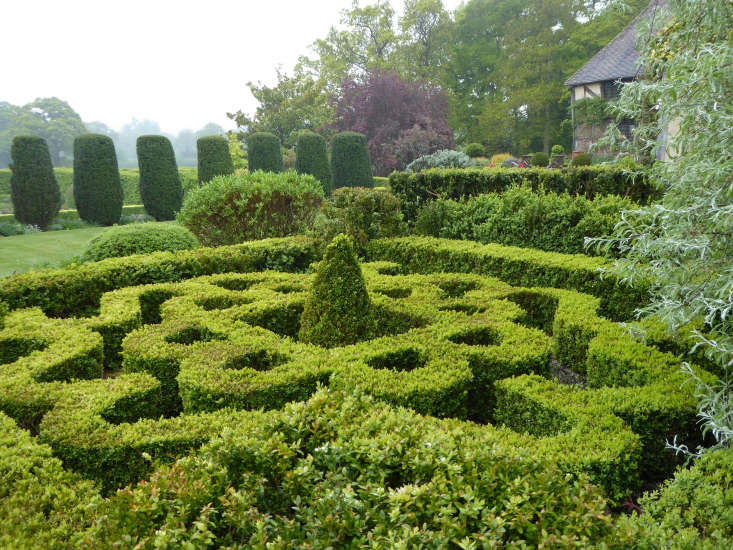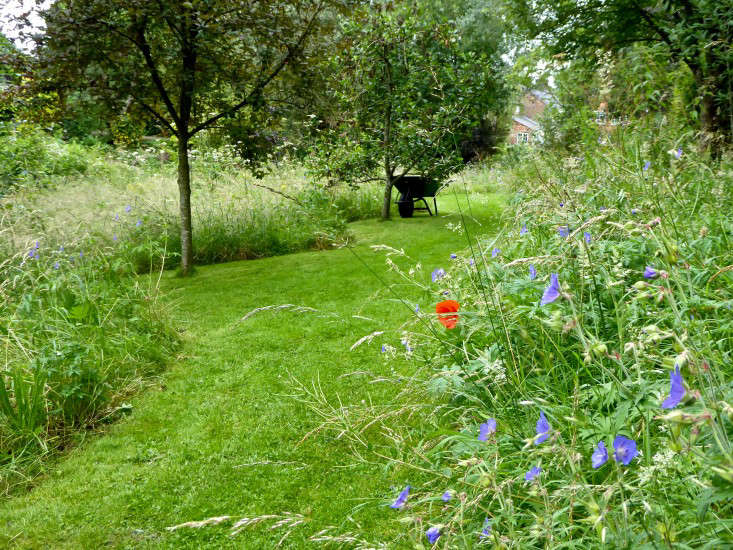Before Vita Sackville-West and Harold Nicolson began to create their now world-famous garden at Sissinghurst Castle, they had a starter garden. Long Barn, an old Kentish house in Sevenoaks, was where the couple experimented with the features that, a century later, they are best known for; striking yew and crisp hedges that create strong garden lines and vistas, romantic woodland areas, and lush borders overflowing with plants.
Today Long Barn is owned by Lars and Rebecca Lemonius, who beautifully maintain the three acres of gardens and meadows as well as several more acres of paddocks beyond. On a wet and thunderous spring day we took a tour:
Photography by Clare Coulson.

The Long Barn refers to the 16th-century barn that was brought up from a local farm and added on to the original house; the oldest part of the house dates to the 14th century and when Vita and Harold arrived in 1915, they began by sculpting terraces on the south-sloping site, creating distinct areas with lawns, borders and retaining walls.


Sackville-West and Nicolson designed bold east-west views and paths across the garden, often punctuated with statuary, a technique they would later refine at Sissinghurst. And then cut right through the middle of them with a path running north to south with a scented rose walk giving stunning views across the whole garden. Despite all this rigorous geometry, Rebecca insists that there’s not a dead straight line here—everything is just slightly off.

The Dutch garden has enormous borders planted into raised beds while the Pleasaunce lawn is edged with more borders that tumble over with penstemons, lavender, nigella, and other cottage garden favorites. But it’s the avenue of clipped Irish yews that defines this area. When the couple planted them Vita wrote to Harold that “they will look silly at first” but that one day they would “draw charabancs full of tourists from London.”

The garden began as three acres but organically other pockets of land were added on. At the top end of the garden, a former tennis court has now been planted as a rose garden (an area that Rebecca is still unsure about) and alongside a sloping orchard of gnarled old fruit trees is enlivened with mown paths and spring bulbs.


How do make an historic garden your own? For Rebecca, it’s about largely following Vita’s planting philosophy (“Cram, cram, cram”) but not religiously so. “I think I follow her ideas, the abundance, but I don’t follow rigidly what was here,” says Rebecca who will sometimes add some of Vita’s favorite plants to borders and encourages plants to spill over walls and edges.


The soil here is almost solid Kentish clay, a fact made worse by its position on a slope at the outskirts of the village. Vita and Harold soon realized that many plants would not survive if they planted straight into the ground and most planting here is done in raised beds, thought to have been designed by Edwin Lutyens. Some beds are currently being refilled with fresh soil, after which Rebecca wants to incorporate plants that will spill over the edges to soften the brick.



When Vita and Harold bought and moved to Sissinghurst in 1930 they retained Long Barn, letting it out, first to a London-based entertainment mogul Sidney Bernstein, and the house played host to a stream of Hollywood stars including Charlie Chaplin. The house was later rented to Charles Lindbergh and his wife, Anne Morrow.

The gardens are open for pre-arranged private group tours (minimum 10 people). Email lemoniul@mac.com for further information.
For more of Vita Sackville-West’s landscaping ideas, see:
- 10 Garden Ideas to Steal from Sissinghurst Castle.
- Required Reading: Vita Sackville-West’s Sissinghurst.
- Garden Visit: Vita’s Sunset Garden.












Have a Question or Comment About This Post?
Join the conversation (0)